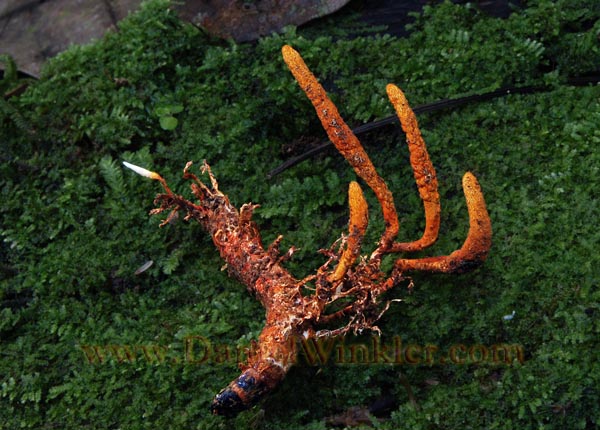Recently I came across a few new scientific publications on Cordyceps. Here is a short overview.
I was glad to see a new article by Yao et al. on the distribution area of Ophiocordyceps sinensis by a group of China-based researchers. The authors claim to having traveled the distribution area extensively, besides sifting through a lot of mostly Chinese sources to outline the current distribution. It does not really contain much new information regarding the extent of the distribution area beyond what my distribution maps (Winkler 2008 & 2009) already are showing. However, most interesting I find their on-site verification of the lowest altitude of caterpillar fungus distribution just around 3000m and debunking older claims of sites in the low 2000m. Also the highest distribution of around 5000m is confirmed. Here a quote: " The lowest altitude recorded was 3,087 m with supporting collections [..] made in Xiaojin County, Sichuan Province. It is conceivable that 3,000 m is in general the reliable lowest altitude for the distribution of O. sinensis. The highest altitude was recorded as 5,048 m [..] collected in Nagqu County, Tibet." And of course I should mention that they collected lot of herbaria samples.
However, Yao et al. claim to have published first records for twelve counties in Tibet AR previously not published does not really hold up. Several of these counties were already reported as Cordyceps sourcing area in the Atlas of Tibet AR (1996) I used as one of my sources for compiling the first Cordyceps distribution map I published in 2005 (Winkler 2005). Anyways, overall it was very helpful that a lot of Chinese language sources were scanned and a bunch of bad sources that reported Ophiocordyceps sinensis to grow outside of its distribution area were debunked.
Another paper authored by a team from researchers in Hong Kong describes microscopy techniques to verify Ophiocordyceps sinensis authenticity. Furthermore the team analyzed over 50 O. sinensis products on the market , the majority being the natural product, but the samples included also pills and clear counterfits. Not surprisingly there was not only caterpillar fungus in many products....
Very interesting from a taxonomic point is an article on Metacordyceps taxonomy by Kepler et al. 2011. So far Metocordyceps was only described from East Asia, but now it is apparent that it is also distributed in the Neotropics. Already in February 2011 I found Metacordyceps in Ecuador's Amazon Rain forest, but back then it was not published yet as distributed in the Americas.
A picture of a Metacordyceps is posted below.
A medical article comparing Ophiocordyceps sinensis with Cyclosporin by Ding et al. 2011, a Chinese team of doctors from Xian was published and concluding that the Cs and cyclosporin recipients did not show significantly different outcome, but Cs recipients had less complications, if I understand the abstract correctly and it gets more techincal quickly.
Sources:
Atlas of AR [Xizang Zizhiqu Dituce] (1996). Zhongguo Ditu Chubanshe Chuban (China Cartographic Publishing House), Beijing, 1-167. (in Chinese)
Au D, Wang L, Yang D, Mok DK, Chan AS, Xu H. 2011. Application of microscopy in authentication of valuable Chinese medicine I--Cordyceps sinensis, its counterfeits, and related products. Microsc Res Tech. 75.1:54-64. pdf
Ding C, Tian PX, Xue W, Ding X, Yan H, Pan X, Feng X, Xiang H, Hou J, Tian X. 2011. Efficacy ofCordyceps sinensis in long term treatment of renal transplant patients. In: Front Biosci (Elite Ed). 2011 1.3:301-7. www.ncbi.nlm.nih.gov/pubmed/21196310
Kepler RM, Sung GH, Ban S, Nakagiri A, Chen MJ, Huang B, Li Z, Spatafora JW. 2012. New teleomorph combinations in the entomopathogenic genus Metacordyceps. Mycologia 104(1):182-97.
Winkler, D. 2005. Yartsa Gunbu - Cordyceps sinensis. Economy, Ethno-mycology & Ecology of a Fungus Endemic to the Tibetan Plateau. A.Boesi & F. Cardi (eds.). Wildlife and plants in traditional and modern Tibet: Conceptions, Exploitation and Conservation. Memorie della Società Italiana di Scienze Naturali e del Museo Civico di Storia Naturale di Milano, Vol. 33.1, 69-85. link
Winkler, D. 2008. Yartsa Gunbu (Cordyceps sinensis) and the Fungal Commodification of the Rural Economy in Tibet AR. Economic Botany 63.2: 291-306. pdf
Yi Li, Xiao-Liang Wang, Lei Jiao, Yi Jiang, Hui Li, Si-Ping Jiang, Ngarong Lhosum Tseiring,
Shen-Zhan Fu, Cai-Hong Dong, Yu Zhan, and Yi-Jian Yao 2011. A Survey of the Geographic Distribution of Ophiocordyceps sinensis. Journal of Microbiology 49.6, pp. 913-919. pdf
